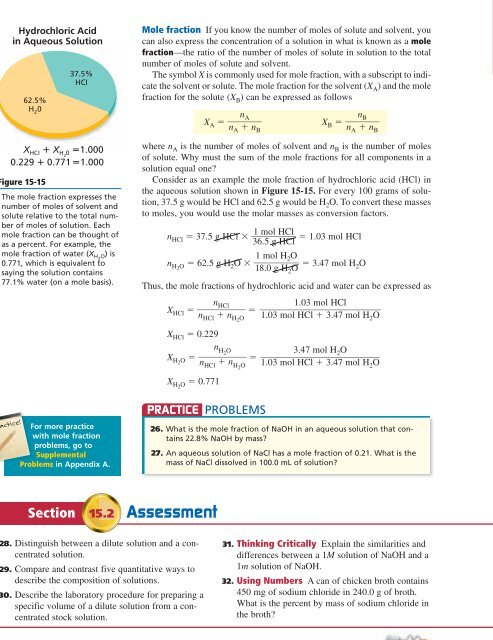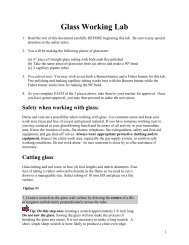Chapter 15: Solutions - Weironline.net
Chapter 15: Solutions - Weironline.net
Chapter 15: Solutions - Weironline.net
You also want an ePaper? Increase the reach of your titles
YUMPU automatically turns print PDFs into web optimized ePapers that Google loves.
Hydrochloric Acid<br />
in Aqueous Solution<br />
62.5%<br />
H 2 0<br />
X HCI � X H2 0 �1.000<br />
0.229 � 0.771 �1.000<br />
Figure <strong>15</strong>-<strong>15</strong><br />
37.5%<br />
HCI<br />
The mole fraction expresses the<br />
number of moles of solvent and<br />
solute relative to the total number<br />
of moles of solution. Each<br />
mole fraction can be thought of<br />
as a percent. For example, the<br />
mole fraction of water (XH2O ) is<br />
0.771, which is equivalent to<br />
saying the solution contains<br />
77.1% water (on a mole basis).<br />
Practice!<br />
For more practice<br />
with mole fraction<br />
problems, go to<br />
Supplemental<br />
Problems in Appendix A.<br />
Section <strong>15</strong>.2 Assessment<br />
28. Distinguish between a dilute solution and a concentrated<br />
solution.<br />
29. Compare and contrast five quantitative ways to<br />
describe the composition of solutions.<br />
30. Describe the laboratory procedure for preparing a<br />
specific volume of a dilute solution from a concentrated<br />
stock solution.<br />
470 <strong>Chapter</strong> <strong>15</strong> <strong>Solutions</strong><br />
Mole fraction If you know the number of moles of solute and solvent, you<br />
can also express the concentration of a solution in what is known as a mole<br />
fraction—the ratio of the number of moles of solute in solution to the total<br />
number of moles of solute and solvent.<br />
The symbol X is commonly used for mole fraction, with a subscript to indicate<br />
the solvent or solute. The mole fraction for the solvent (X A ) and the mole<br />
fraction for the solute (X B ) can be expressed as follows<br />
nA<br />
nB<br />
XA � �� X<br />
nA �<br />
B � �� nA �<br />
n B<br />
where n A is the number of moles of solvent and n B is the number of moles<br />
of solute. Why must the sum of the mole fractions for all components in a<br />
solution equal one?<br />
Consider as an example the mole fraction of hydrochloric acid (HCl) in<br />
the aqueous solution shown in Figure <strong>15</strong>-<strong>15</strong>. For every 100 grams of solution,<br />
37.5 g would be HCl and 62.5 g would be H 2 O. To convert these masses<br />
to moles, you would use the molar masses as conversion factors.<br />
nHCl � 37.5 g HCl ��<br />
1 molH<br />
�<br />
Cl<br />
� 1.03 mol HCl<br />
36.5<br />
g HCl<br />
nH2O � 62.5 g H2O �� 1 molH2O<br />
� � 3.47 mol H<br />
18.0<br />
g H O<br />
2O Thus, the mole fractions of hydrochloric acid and water can be expressed as<br />
nHCl<br />
1.03 mol HCl<br />
XHCl ��� � ����<br />
nHCl � n 1.03 mol HCl � 3.47 mol H2O H 2 O<br />
XHCl � 0.229<br />
XH2O �� nH2O<br />
nHCl �<br />
�<br />
n<br />
�<br />
H2O X H2 O<br />
� 0.771<br />
PRACTICE PROBLEMS<br />
2<br />
31. Thinking Critically Explain the similarities and<br />
differences between a 1M solution of NaOH and a<br />
1m solution of NaOH.<br />
32. Using Numbers A can of chicken broth contains<br />
450 mg of sodium chloride in 240.0 g of broth.<br />
What is the percent by mass of sodium chloride in<br />
the broth?<br />
n B<br />
3.47 mol H 2 O<br />
����<br />
1.03 mol HCl � 3.47 mol H 2O<br />
26. What is the mole fraction of NaOH in an aqueous solution that contains<br />
22.8% NaOH by mass?<br />
27. An aqueous solution of NaCl has a mole fraction of 0.21. What is the<br />
mass of NaCl dissolved in 100.0 mL of solution?<br />
chemistrymc.com/self_check_quiz




